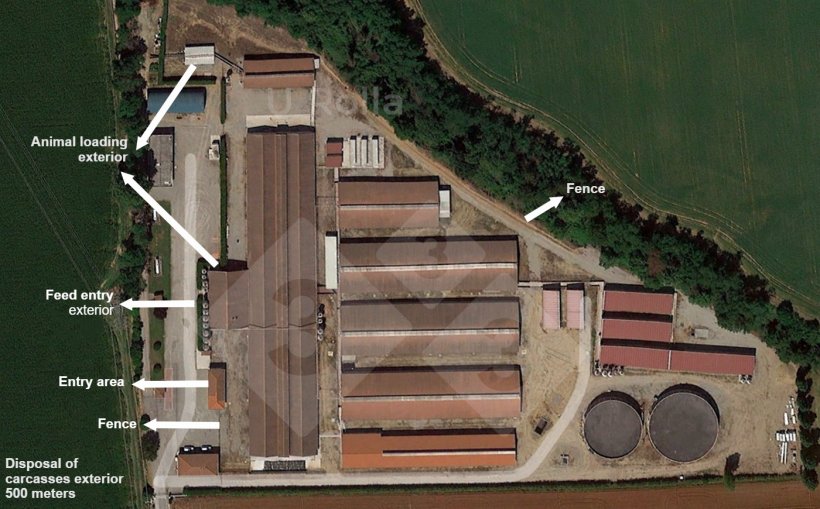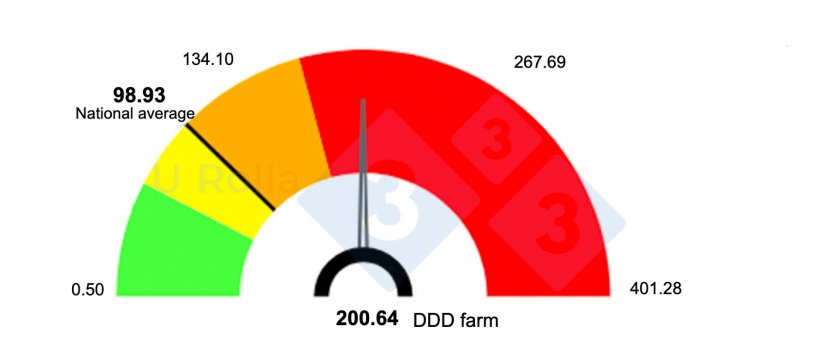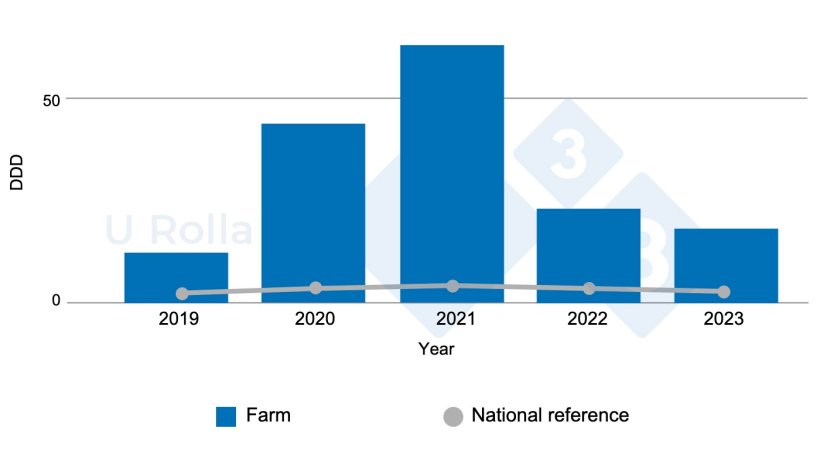The farm discussed in this article is a site I holding about 2,500 sows and it is located in an area with a high pig density. Piglets are weaned at four weeks of age and taken to off-site nurseries. Depending on capacity, the nurseries are filled with piglets from two or three weeks' worth of weanings. Over the years, the farm has gone from bringing in external replacement animals to raising its own replacements and bringing in only semen doses.
The animals are regularly vaccinated against PRRSV. In terms of external biosecurity, the farm is well structured and managed, as seen in the picture (Figure 1): no vehicles enter the clean area and no people enter without passing through a specific area equipped with a dedicated shower and clothing; dead animal collection is done in the external area.


Figure 1. Aerial view of sow farm.
Since the farm is located in a high-density area, it has been, and continues to be, PRRSV unstable; in fact, a new strain of PRRSV enters the farm twice a year on average, with consequent repercussions on sow reproduction, but especially on nursery mortality.
The increase in mortality in the weeks immediately after an outbreak is due to the poor quality of the weaned piglets. In the following weeks, the increase in mortality is not so much, or at least not only, due to the increase in respiratory symptoms caused by the PRRS virus but mainly to the increase in secondary bacterial infections: Escherichia coli, Glasserella parasuis, and mainly Streptococcus suis.
Since 2018, as prudent antibiotic use guidelines have been adapted, research and testing aimed at reducing nursery mortality while decreasing antibiotic use and discontinuing the use of critically important antimicrobials (CIAs) have intensified.
While farrowing and post-weaning diarrhea problems (E. coli) resulted in relatively few losses and moderate antibiotic use, this was not the case for S. suis.
The use of penicillins (amoxicillin) was necessary both in sucking piglets, with several intramuscular injections, and at the nursery phase via oral and intramuscular routes, with use being much higher than our objectives (see Figures 2 and 3). And despite their therapeutic use and metaphylaxis, losses were still clearly high. Figure 2. Comparison of antibiotic use on the sow farm plus nurseries with the national average using Classyfarm, a computer system from the Ministry of Health for monitoring farms. DDD (average dose of an active ingredient valued in mg per kg live weight). Figure 3. Analysis of drug consumption by category in the weaning phase according to Classyfarm, a computerized system from the Ministry of Health for monitoring farms.

After testing the use of an aluminum hydroxide-based autogenous vaccine in 2018 with no improvement, in 2020 it was decided to carry out a project to analyze in detail the strains circulating in sows and weaned piglets.
The result was that the serotype circulating in both sows and weaned piglets was Streptococcus suis serotype 9. At the same time, virulence factors associated with this serotype were also evaluated. Several virulence factors are expressed by S. suis. The most significant are muramidase-releasing protein (mrp), encoded by the mrp gene, extracellular factor (ef), encoded by the epf gene, and suilysin toxin (hemolysin), encoded by the sly gene (Silva et al., 2006).
Our serotype was always associated with the virulence factors mrp and sly, as seen in Table 1. Therefore, we also tried to use an autovaccine made from serotype 9 with Montanide as an adjuvant. The protocol called for double vaccinating the breeding sows and eventually vaccinating the piglets.
Table 1: Isolates in sows and weaned piglets: serotype, virulence factors, and antimicrobial susceptibility. (S = sensitive, R = resistant, I = intermediate).
| Sample | serotype | Virulence factor | Ceftiofur | Penicillin | Ampicilin | Sulfamethoxazole+ Trimethoprim |
Enrofloxacin | Tetracycline | Florfenicol |
|---|---|---|---|---|---|---|---|---|---|
| Brain | 9 | mrp/sly | S | I | S | S | I | R | S |
| Brain | 2 | neg | S | S | S | S | R | R | S |
| Brain | 9 | mrp/sly | S | R | S | S | S | R | S |
| Joint | 9 | mrp/sly | S | R | S | S | I | R | S |
| Brain | 9 | mrp/sly | S | R | I | S | R | R | S |
| Spleen | 9 | mrp/sly | S | I | S | S | I | R | S |
| Brain | 9 | mrp/sly | S | R | I | S | I | R | S |
This procedure also failed to result in any significant improvement in terms of decreased mortality and/or decreased antibiotic use.
Other trials were conducted from 2018 to 2021: use of monolaurin, acidifiers, and commercial vaccines. None led to improvements.
The health status, especially in weaned pigs, did not meet the objectives: economic losses were due to both mortality and depreciation of piglets that could not be sold at market value (Figure 4). In the last year analyzed (2020-2021), 15% of weaned piglets were not sold or were not sold at market value. Additionally, the objective of decreasing the use of antibiotics was also not met.

Figure 4. Evolution of mortality (%) and proportion of second-category piglets at weaning from January 2018 to March 2022.
In the fall of 2021, it was decided to proceed with a total depopulation/repopulation of the farm to "reset" the bacterial load of the farm. There was little we could do to combat the PRRS virus; our goal was to limit secondary bacterial co-infections.
In agreement with the genetics company that was supplying the breeding stock, a multiplication pyramid was identified that met the customer's needs. A thorough screening of the future source farm to repopulate the farm was then carried out, especially for S. suis:
- 60 laryngeal swabs were taken from various ages of piglets, when they may be most susceptible to infection (5 to 12 weeks of age).
- The transport medium used was amies + activated charcoal (higher detection sensitivity).
- Of the 60 samples, 45 isolates were obtained, which did not correspond to Streptococcus strains 1, 2, 4, 7, or 9 (related to clinical cases).
- Only 4 of the 45 nontypeable S. suis isolates had any of the 3 streptococcal virulence factors (epf, mrp, or sly) but none had all three together.
It seemed quite unlikely that animals in this multiplication pyramid could present with a streptococcal-related meningitis clinical presentation. Moreover, in this multiplication units, the use of aminopenicillins was practically nil.
Reassured by this epidemiological investigation, the arrival of the population animals was planned.
The first farrowings took place in early 2023. Precisely at the time of the first weaning, the farm was affected by a new strain of PRRSV. Despite this, the data available to date are reassuring in terms of mortality (Figure 5) and antibiotic use (Figure 6). Thus, despite the fact that the first batches started with piglets born after a PRRS outbreak and also were composed entirely of piglets from primiparous sows, mortality tended to be approximately 50% lower than in the preceding period.

Figure 5. Mortality (%) and proportion of second-category piglets at weaning before (October 2020 to March 2022) and after (March to July 2023) depopulation/repopulation.

Figure 6. Evolution of antimicrobial consumption (DDD, average dose of an active ingredient valued in mg per kg live weight) on the sow farm compared to the national average (2019 data are partial).
In the decision-making process and in defining the business plan, tangible and measurable values such as improved production performance and saving on medication were considered, but at the same time, ethical aspects and thus compliance with guidelines on the prudent use of antimicrobials were also given decisive weight. The farm needed some maintenance and remodeling work, so it was empty for longer than usual.
Although there may be considerable variations depending on the timing of the market, taking into account the minimum depopulation/repopulation time without considering the extraordinary projects, a return on investment is expected in about 2.5 to 3.5 years, excluding interest expenses.





